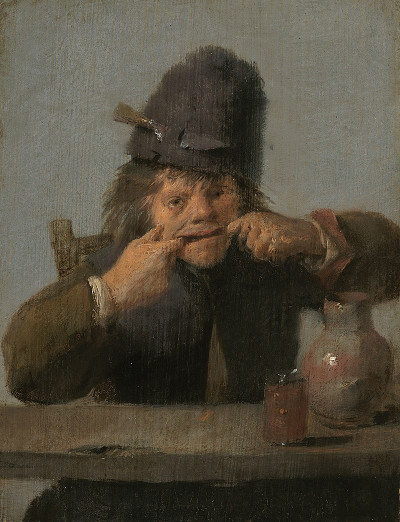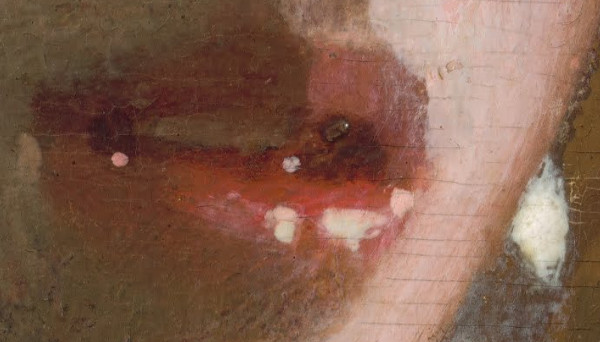Girl with a Red Hat
c. 1665–1667Oil on panel
23.2 x 18.1 cm. (9 1/8 x 7 1/8 in.)
National Gallery of Art, Washington, D.C.
Aside from the expectant expression on the young woman's face, much of the vivacity of this extraordinary painting stems from the manner which it is painted. The reflections of light take shape as pale, densely applied brushstrokes of white and yellow paint which animate the surfaces of the different objects and materials and bring them close to the picture surface, reminding us that we in looking at a painted object in contrast to these strongly lit areas, the red hat and blue garment are painted over darker under layers, which give the colors warmth. The sumptuousness of the materials and the depth and intensity of the color range used by Vermeer contributed to the sense of warmth which is a key element in this work's aesthetic.
To understand the subject of this painting we need to set it in the context of the tronien, a Dutch term which refers to paintings of busts or heads, generally wearing hats or exotic clothes and depicting anonymous (fig. 1) or fictive characters. This type of work was to some extent experimental, and allowed artists to investigate the expression (fig. 2) and clothing of the figures rather than focus on a faithful reproduction of their features. The exotic dress of the girl in the present painting and her expectant expression with its half-open mouth, intense gaze and impression of having just turned her head to look at us, indicate that this work is a tronie.

Michael Sweerts
c. 1654
Oil on panel, 50.6 x 37.5 cm.
John Paul Getty Museum of Art, Los Angeles

Adriaen Brouwer
c. 1632–1635
Oil on panel, 13.7 x 10.5 cm.
National Gallery of Art, Washington
The small size of the painting and the fact that it is painted on panel make it unusual within Vermeer's oeuvre and have led some authors to doubt its attribution. However, the technical devices evident in the work, such as the colors of the underlayers and the way of applying lights and color, as well as the impression of immediacy and control which the girl's pose conveys, all point to Vermeer. Some of the specialists who have doubted Vermeer's authorship have pointed to the incorrect alignment of the two lions' heads on the chair on which the girl leans her right arm. However, it is characteristic of Vermeer to modify his scenes with the aim of creating the spatial and formal relationships which constitute his pictorial language. In other words, his paintings respond to a logic which is more visual than geometric.
Among all of Vermeer's paintings, this is perhaps the one which comes closest to the type of image produced by an instrument known as the camera obscura, an optical device which aroused the curiosity of Dutch scientists and artists in Vermeer's time. With the aid of a lens, it allowed the user to project an image from the exterior onto a wall in a dark room or on the surface of a small chamber specially prepared for it. While experts are not in agreement as to how or to what extent Vermeer and other artists used the camera obscura to compose their paintings, it is certain that the images which it produced characterize by the intensity of the colors and contrasts and the presence of small blurred points of light (fig. 3) interested and inspired Vermeer.

Johannes Vermeer
c. 1665–1667
Oil on panel, 23.2 x 18.1 cm.
National Gallery of Art, Washington, D.C

Johannes Vermeer
c. 1665–1667
Oil on panel, 23.2 x 18.1 cm.
National Gallery of Art, Washington, D.C.
For a painter who excelled in the observation of light there was hardly a more suitable vehicle than a subject like this one, with its comparisons of skin, silk, and pearls, moist lips (their colour enhanced by the hat), soft and smooth fabrics all shiny surfaces set against the duller tones and rougher texture of the tapestry, which in addition to its complementary colours provides sympathetic shapes such as the curved lines descending from the face to the hand, the curtain-like closure of the upper left corner, and the border framing the right side of the image. Similarly, the lion's-head finials (fig. 4), in addition to displaying the artist's talent for describing effects of light, are placed with an eye to their effect on the figure, which is given a zone of space and a stability that it would not have otherwise. Discussions of whether the finials line up are illogical on two counts, firstly because, if real, the finials would belong to two different chairs (both heads would be right-hand finials, the nearest one belonging to a chair out of view to the lower left, the other to a chair whose left-hand finial is covered by the woman's drapery); and secondly because the finials are placed arbitrarily, like many other motifs in the artist's work.
'A Tronie in Antique Clothing, unusually artful', as well as Another ditto Vermeer' and A pendant of the same', are listed consecutively in the catalogue of the 1696 Dissius sale (Montias 1989, doc. 439, lots 38–40). This suggests that one or more of the known paintings of this type had been purchased by his patron Pieter van Ruijven. Vermeer must have been an aficionado of tronies, considering that two by Carel Fabritius and two by Samuel van Hoogstraten (fig. 5) were listed in the inventory of his estate, and that he himself painted at least four of them. However, nothing quite prepares one for this example. In terms of technique it is typical of Vermeer, as Wheelock has explained. But the sheer invention is unexpected, a flash of inspiration in an artist who normally proceeded with the greatest of care.
Circle of Samuel van Hoogstraten
Oil on panel, 54.3 x 46.6 cm.
Private collection

